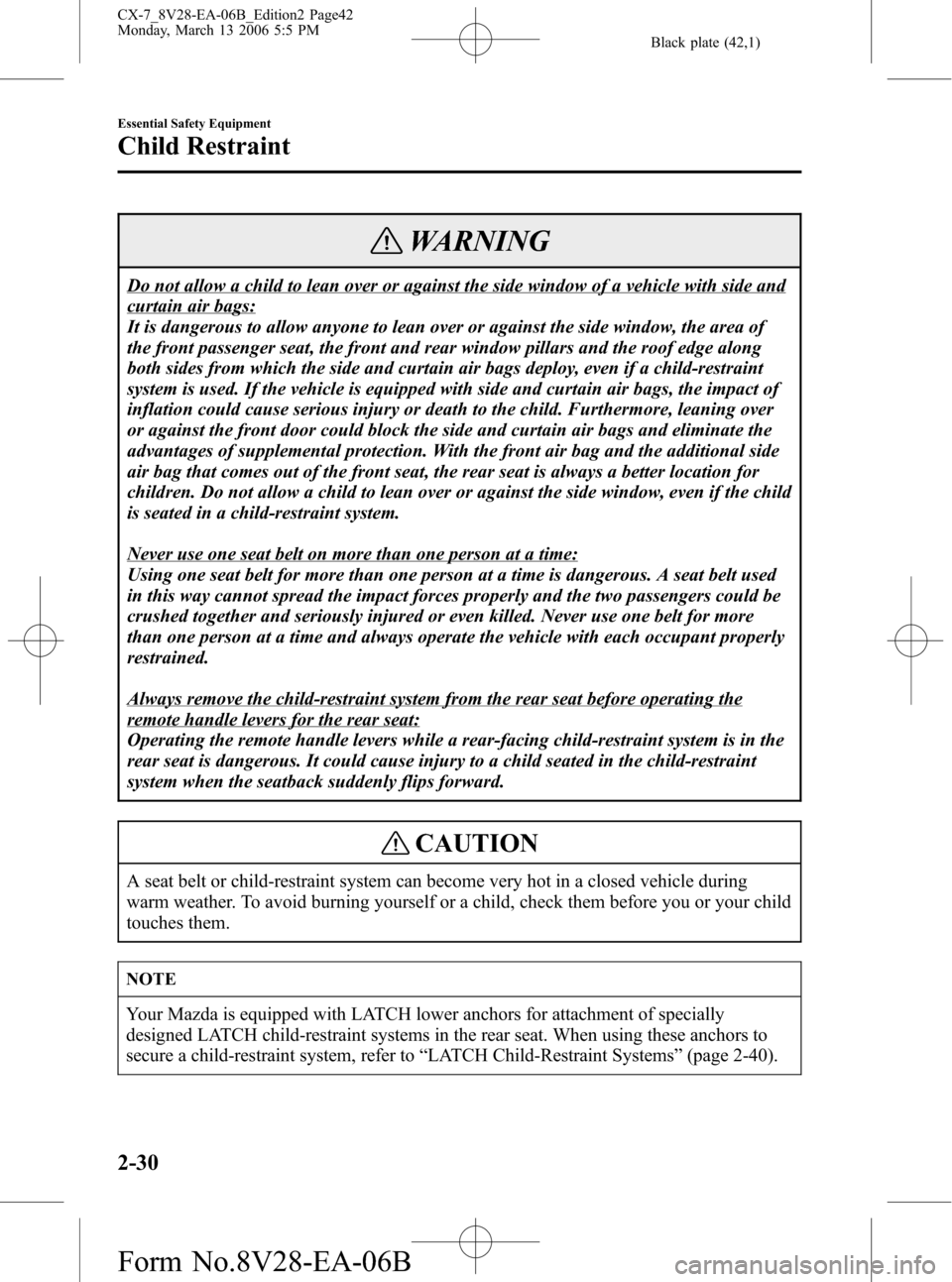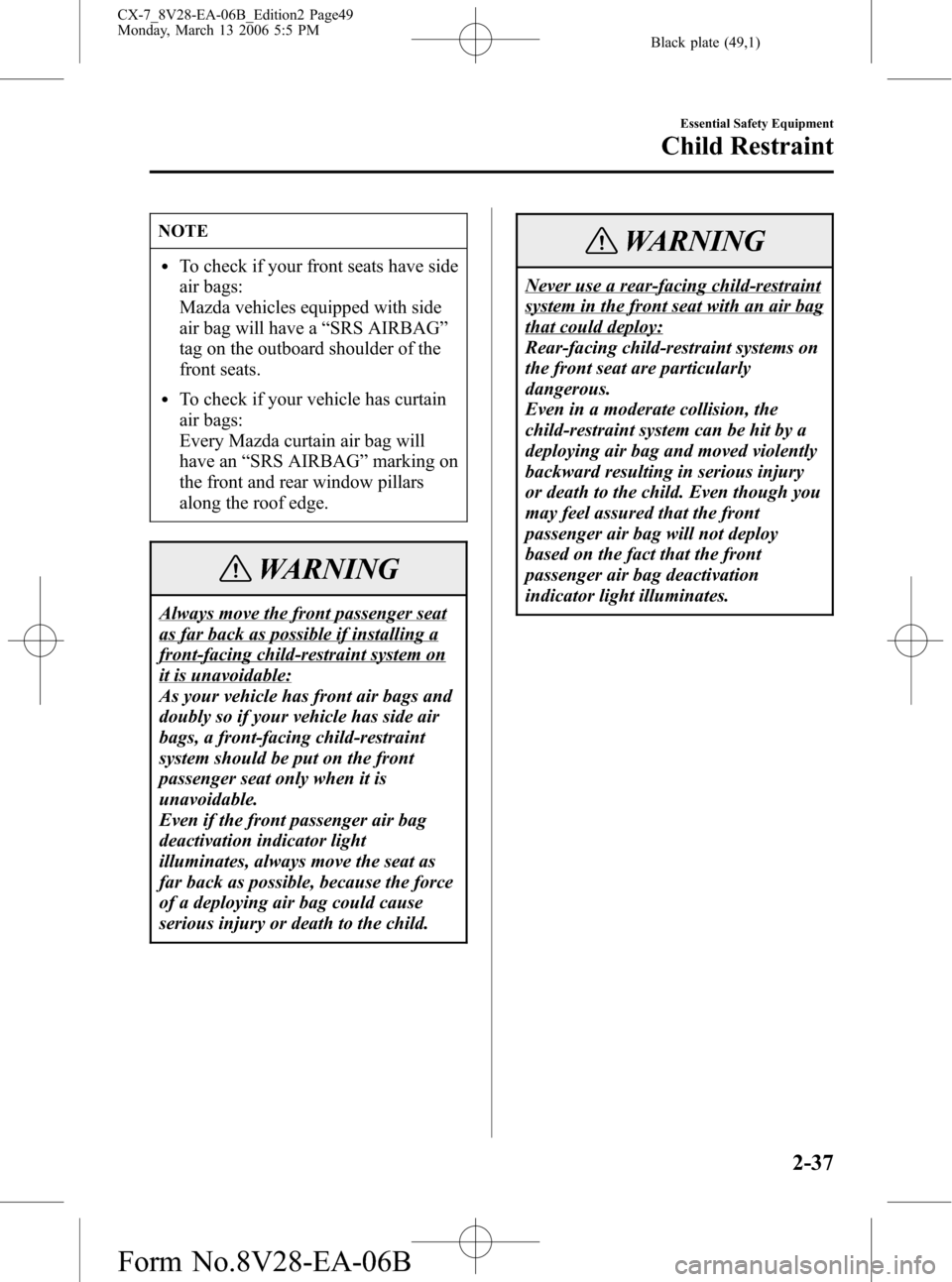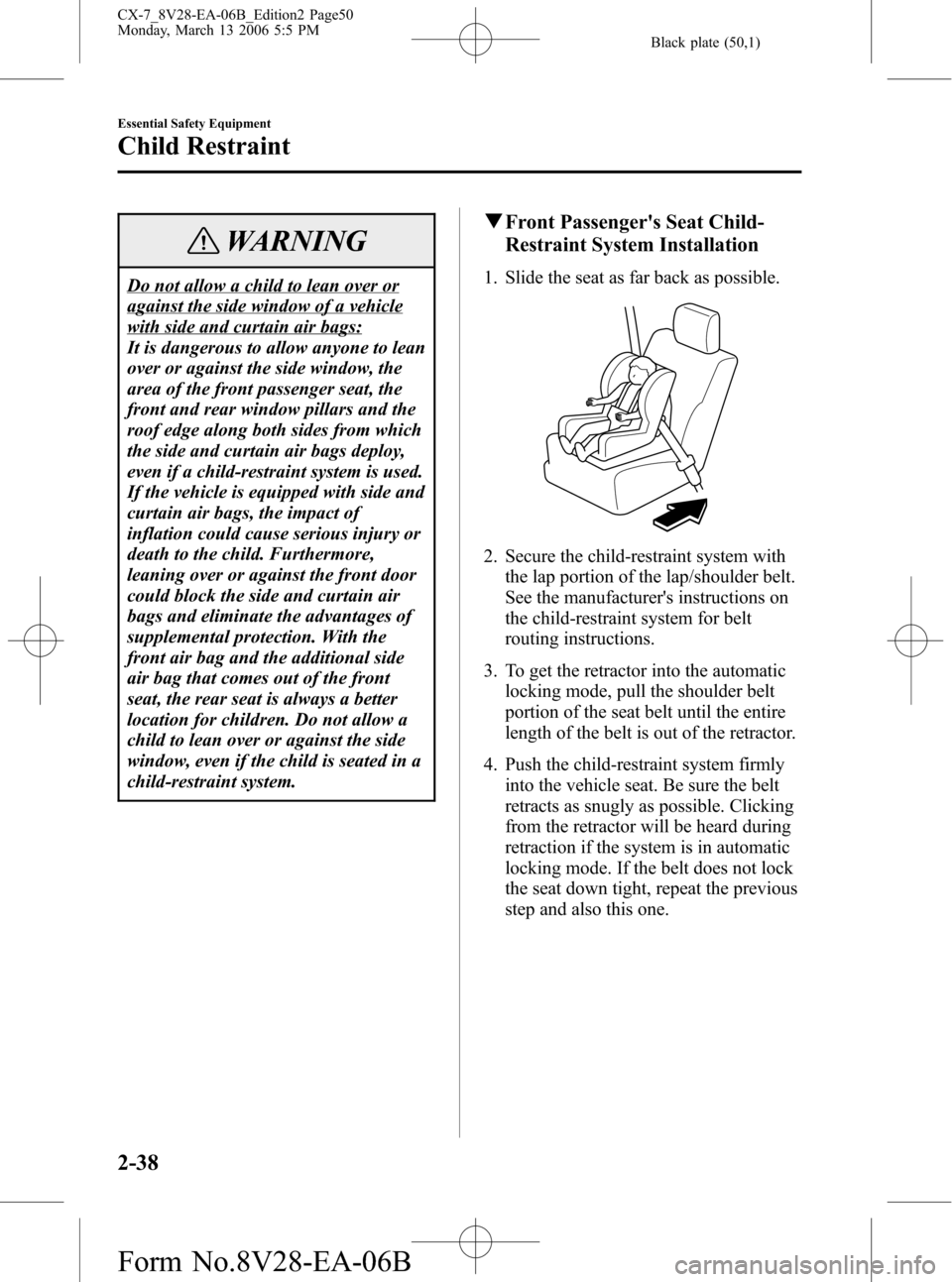MAZDA MODEL CX-7 2007 (in English) Service Manual
Manufacturer: MAZDA, Model Year: 2007, Model line: MODEL CX-7, Model: MAZDA MODEL CX-7 2007Pages: 406, PDF Size: 6.11 MB
Page 41 of 406

Black plate (41,1)
WARNING
Avoid putting a front-facing child-restraint system on the front passenger seat:
A front-facing child-restraint system should only be put on the front seat when it is
unavoidable. In a collision, the force of a deploying air bag could cause serious injury
or death to the child. Always move the seat as far back as possible.
Seating a child in a child-restraint system on the front passenger seat is dangerous:
Your vehicle is equipped with front passenger seat weight sensors. Even with front
passenger seat weight sensors, if you must use the front passenger seat to seat a child,
using a child-restraint system on the front passenger seat under the following
conditions increases the danger of the front passenger air bag deploying and could
result in serious injury or death to the child.
lThe total seated weight of the child with the child-restraint system on the front
passenger seat is approximately 30 kg (66 lb) or more with a child in the child-
restraint system.
lLuggage or other items are placed on the seat with the child in the child-restraint
system.
lA rear passenger or luggage pushing or pulling down on the front passenger
seatback.
lA rear passenger puts their feet on the front seat rails.lLuggage or other items are placed on the seatback or hung on the head restraint.lThe seat is washed.lLiquids are spilled on the seat.lThe front passenger seat is moved backward, pushing into luggage or other items
placed behind it.
lThe front passenger seatback contacts the rear seat.lLuggage or other items are placed between the front passenger seat and driver seat.lAny accessories increasing the total seated weight on the front passenger seat are
attached to the front passenger seat.
The designated positions with seat belts on the rear seats are the safest places for
children. Always use seat belts and child restraints.
Essential Safety Equipment
Child Restraint
2-29
CX-7_8V28-EA-06B_Edition2 Page41
Monday, March 13 2006 5:5 PM
Form No.8V28-EA-06B
Page 42 of 406

Black plate (42,1)
WARNING
Do not allow a child to lean over or against the side window of a vehicle with side and
curtain air bags:
It is dangerous to allow anyone to lean over or against the side window, the area of
the front passenger seat, the front and rear window pillars and the roof edge along
both sides from which the side and curtain air bags deploy, even if a child-restraint
system is used. If the vehicle is equipped with side and curtain air bags, the impact of
inflation could cause serious injury or death to the child. Furthermore, leaning over
or against the front door could block the side and curtain air bags and eliminate the
advantages of supplemental protection. With the front air bag and the additional side
air bag that comes out of the front seat, the rear seat is always a better location for
children. Do not allow a child to lean over or against the side window, even if the child
is seated in a child-restraint system.
Never use one seat belt on more than one person at a time:
Using one seat belt for more than one person at a time is dangerous. A seat belt used
in this way cannot spread the impact forces properly and the two passengers could be
crushed together and seriously injured or even killed. Never use one belt for more
than one person at a time and always operate the vehicle with each occupant properly
restrained.
Always remove the child-restraint system from the rear seat before operating the
remote handle levers for the rear seat:
Operating the remote handle levers while a rear-facing child-restraint system is in the
rear seat is dangerous. It could cause injury to a child seated in the child-restraint
system when the seatback suddenly flips forward.
CAUTION
A seat belt or child-restraint system can become very hot in a closed vehicle during
warm weather. To avoid burning yourself or a child, check them before you or your child
touches them.
NOTE
Your Mazda is equipped with LATCH lower anchors for attachment of specially
designed LATCH child-restraint systems in the rear seat. When using these anchors to
secure a child-restraint system, refer to“LATCH Child-Restraint Systems”(page 2-40).
2-30
Essential Safety Equipment
Child Restraint
CX-7_8V28-EA-06B_Edition2 Page42
Monday, March 13 2006 5:5 PM
Form No.8V28-EA-06B
Page 43 of 406

Black plate (43,1)
Installing Child-Restraint
Systems
Accident statistics reveal that a child is
safer in the rear seat. The front passenger's
seat is clearly the worst choice for any
child under 12, and with rear-facing child-
restraint systems it is clearly unsafe due to
air bags.
Some child-restraint systems now come
with tethers and therefore must be
installed on the seats that take tethers to
be effective. In your Mazda, tethered
child-restraint systems can only be
accommodated in the three positions on
the rear seat.
Even if your vehicle is equipped with
front passenger seat weight sensors (page
2-58), which automatically deactivates the
front passenger air bag, a rear seat is the
safest place for a child of any age or size.
Some child-restraint systems also employ
specially designed LATCH attachments;
refer to“LATCH Child-Restraint
Systems”(page 2-40).
WARNING
Tethered Child-Restraint Systems
Work Only on Tether-Equipped Rear
Seats:
Installation of a tether equipped child-
restraint system in the front
passenger's seat defeats the safety
design of the system and will result in
an increased chance of serious injury
if the child-restraint system goes
forward without benefit of being
tethered.
Place tether equipped child-restraint
systems where there are tether
anchors.
qRear Outboard Seat Child-
Restraint System Installation
Follow these instructions when using a
child-restraint system, unless you are
attaching a LATCH-equipped child-
restraint system to the rear LATCH lower
anchors. Refer to“LATCH Child-
Restraint Systems”(page 2-40).
NOTE
Follow the child-restraint system
manufacturer's instructions carefully. If
you are not sure whether you have a
LATCH system or tether, check in the
child-restraint system manufacturer's
instructions and follow them
accordingly. Depending on the type of
child-restraint system, it may not
employ seat belts which are in
automatic locking mode.
Essential Safety Equipment
Child Restraint
2-31
CX-7_8V28-EA-06B_Edition2 Page43
Monday, March 13 2006 5:5 PM
Form No.8V28-EA-06B
Page 44 of 406

Black plate (44,1)
1. Make sure the seatback is securely
latched by pushing it back until it is
fully locked.
2. Secure the child-restraint system with
the lap portion of the lap/shoulder belt.
See the manufacturer's instructions on
the child-restraint system for belt
routing instructions.
3. To get the retractor into the automatic
locking mode, pull the shoulder belt
portion of the seat belt until the entire
length of the belt is out of the retractor.4. Push the child-restraint system firmly
into the vehicle seat. Be sure the belt
retracts as snugly as possible. Clicking
from the retractor will be heard during
retraction if the system is in the
automatic locking mode. If the belt
does not lock the seat down tight,
repeat this step.
NOTE
Inspect this function before each use of
the child-restraint system. You should
not be able to pull the shoulder belt out
of the retractor while the system is in
the automatic locking mode. When you
remove the child-restraint system, be
sure the belt fully retracts to return the
system to emergency locking mode
before occupants use the seat belts.
5. If your child-restraint system requires
the use of a tether strap, hook and
tighten the tether strap after raising the
head restraint by following the
manufacturer's instructions.
2-32
Essential Safety Equipment
Child Restraint
CX-7_8V28-EA-06B_Edition2 Page44
Monday, March 13 2006 5:5 PM
Form No.8V28-EA-06B
Page 45 of 406

Black plate (45,1)
Anchor bracket location
Tether strap position
Tether strap
WARNING
Use the tether and tether anchor only
for a child-restraint system:
Using the tether or tether anchor to
secure anything but a child-restraint
system is dangerous. This could
weaken or damage the tether or tether
anchor and result in injury.
Always route the tether strap between
the head restraint and the seatback:
Routing the tether strap on top of the
head restraint is dangerous. In a
collision the tether strap could slide off
the head restraint and loosen the
child-restraint system. The child-
restraint system could move which
may result in death or injury to the
child.
qCenter-Rear Seat Child-Restraint
System Installation
Follow these instructions when using a
child-restraint system, unless you are
attaching a LATCH-equipped child-
restraint system to the rear LATCH lower
anchors. Refer to“LATCH Child-
Restraint Systems”(page 2-40).
NOTE
Follow the child-restraint system
manufacturer's instructions carefully. If
you are not sure whether you have a
LATCH system or tether, check in the
child-restraint system manufacturer's
instructions and follow them
accordingly. Depending on the type of
child-restraint system, it may not
employ seat belts which are in
automatic locking mode.
Essential Safety Equipment
Child Restraint
2-33
CX-7_8V28-EA-06B_Edition2 Page45
Monday, March 13 2006 5:5 PM
Form No.8V28-EA-06B
Page 46 of 406

Black plate (46,1)
1. Make sure the seatback is securely
latched by pushing it back until it is
fully locked.
2. Secure the child-restraint system with
the lap portion of the lap/shoulder belt.
See the manufacturer's instructions on
the child-restraint system for belt
routing instructions.
3. To get the retractor into the automatic
locking mode, pull the shoulder belt
portion of the seat belt until the entire
length of the belt is out of the retractor.4. Push the child-restraint system firmly
into the vehicle seat. Be sure the belt
retracts as snugly as possible. Clicking
from the retractor will be heard during
retraction if the system is in the
automatic locking mode. If the belt
does not lock the seat down tight,
repeat this step.
NOTE
Inspect this function before each use of
the child-restraint system. You should
not be able to pull the shoulder belt out
of the retractor while the system is in
the automatic locking mode. When you
remove the child-restraint system, be
sure the belt fully retracts to return the
system to emergency locking mode
before occupants use the seat belts.
2-34
Essential Safety Equipment
Child Restraint
CX-7_8V28-EA-06B_Edition2 Page46
Monday, March 13 2006 5:5 PM
Form No.8V28-EA-06B
Page 47 of 406

Black plate (47,1)
5. If your child-restraint system requires
the use of a tether strap, hook and
tighten the tether strap. First, remove
the anchor bracket cover on the rear
end trim.
6. Flip over the trunk board.
Trunk board
7. Fold the trunk board into the position
shown in the figure.
8. Latch the hook onto the anchor
bracket, and tighten the tether strap
following the child-restraint system
manufacturer's instructions.
9. Push the trunk board down to its
original position.
Essential Safety Equipment
Child Restraint
2-35
CX-7_8V28-EA-06B_Edition2 Page47
Monday, March 13 2006 5:5 PM
Form No.8V28-EA-06B
Page 48 of 406

Black plate (48,1)
WARNING
Use the tether and tether anchor only
for a child-restraint system:
Using the tether or tether anchor to
secure anything but a child-restraint
system is dangerous. This could
weaken or damage the tether or tether
anchor and result in injury.
Always route the tether strap for the
center-rear seat position to the correct
tether anchor position:
Routing the tether strap for the center-
rear seat position to one of the other
tether anchor positions on the
outboard seatbacks is dangerous. In a
collision, the tether strap could slide
and loosen the child-restraint system.
The child-restraint system could move
which may result in death or injury to
the child.
qIf You Must Use the Front Seat
for Children
If you cannot put all children in the rear
seat, at least put the smallest children in
the rear and be sure the largest child up
front uses the shoulder belt over the
shoulder.
NEVER put a rear-facing child-restraint
system on the front passenger seat, even
with a seat weight sensor equipped
vehicle.
This seat is also not set up for tethered
child-restraint systems, put them in one of
the rear seat positions set up with tether
anchors.
Likewise the LATCH child-restraint
system cannot be secured in the front
passenger's seat and should be used in the
rear seat.
Don't allow anyone to sleep against the
side window if you have an optional side
and curtain air bag, it could cause serious
injuries to an out of position occupant. As
children more often sleep in cars, it is
better to put them in the rear seat. If
installing the child-restraint system on the
front seat is unavoidable, follow these
instructions when using a front-facing
child-restraint system in the front
passenger's seat.
2-36
Essential Safety Equipment
Child Restraint
CX-7_8V28-EA-06B_Edition2 Page48
Monday, March 13 2006 5:5 PM
Form No.8V28-EA-06B
Page 49 of 406

Black plate (49,1)
NOTE
lTo check if your front seats have side
air bags:
Mazda vehicles equipped with side
air bag will have a“SRS AIRBAG”
tag on the outboard shoulder of the
front seats.
lTo check if your vehicle has curtain
air bags:
Every Mazda curtain air bag will
have an“SRS AIRBAG”marking on
the front and rear window pillars
along the roof edge.
WARNING
Always move the front passenger seat
as far back as possible if installing a
front-facing child-restraint system on
it is unavoidable:
As your vehicle has front air bags and
doubly so if your vehicle has side air
bags, a front-facing child-restraint
system should be put on the front
passenger seat only when it is
unavoidable.
Even if the front passenger air bag
deactivation indicator light
illuminates, always move the seat as
far back as possible, because the force
of a deploying air bag could cause
serious injury or death to the child.
WARNING
Never use a rear-facing child-restraint
system in the front seat with an air bag
that could deploy:
Rear-facing child-restraint systems on
the front seat are particularly
dangerous.
Even in a moderate collision, the
child-restraint system can be hit by a
deploying air bag and moved violently
backward resulting in serious injury
or death to the child. Even though you
may feel assured that the front
passenger air bag will not deploy
based on the fact that the front
passenger air bag deactivation
indicator light illuminates.
Essential Safety Equipment
Child Restraint
2-37
CX-7_8V28-EA-06B_Edition2 Page49
Monday, March 13 2006 5:5 PM
Form No.8V28-EA-06B
Page 50 of 406

Black plate (50,1)
WARNING
Do not allow a child to lean over or
against the side window of a vehicle
with side and curtain air bags:
It is dangerous to allow anyone to lean
over or against the side window, the
area of the front passenger seat, the
front and rear window pillars and the
roof edge along both sides from which
the side and curtain air bags deploy,
even if a child-restraint system is used.
If the vehicle is equipped with side and
curtain air bags, the impact of
inflation could cause serious injury or
death to the child. Furthermore,
leaning over or against the front door
could block the side and curtain air
bags and eliminate the advantages of
supplemental protection. With the
front air bag and the additional side
air bag that comes out of the front
seat, the rear seat is always a better
location for children. Do not allow a
child to lean over or against the side
window, even if the child is seated in a
child-restraint system.
qFront Passenger's Seat Child-
Restraint System Installation
1. Slide the seat as far back as possible.
2. Secure the child-restraint system with
the lap portion of the lap/shoulder belt.
See the manufacturer's instructions on
the child-restraint system for belt
routing instructions.
3. To get the retractor into the automatic
locking mode, pull the shoulder belt
portion of the seat belt until the entire
length of the belt is out of the retractor.
4. Push the child-restraint system firmly
into the vehicle seat. Be sure the belt
retracts as snugly as possible. Clicking
from the retractor will be heard during
retraction if the system is in automatic
locking mode. If the belt does not lock
the seat down tight, repeat the previous
step and also this one.
2-38
Essential Safety Equipment
Child Restraint
CX-7_8V28-EA-06B_Edition2 Page50
Monday, March 13 2006 5:5 PM
Form No.8V28-EA-06B